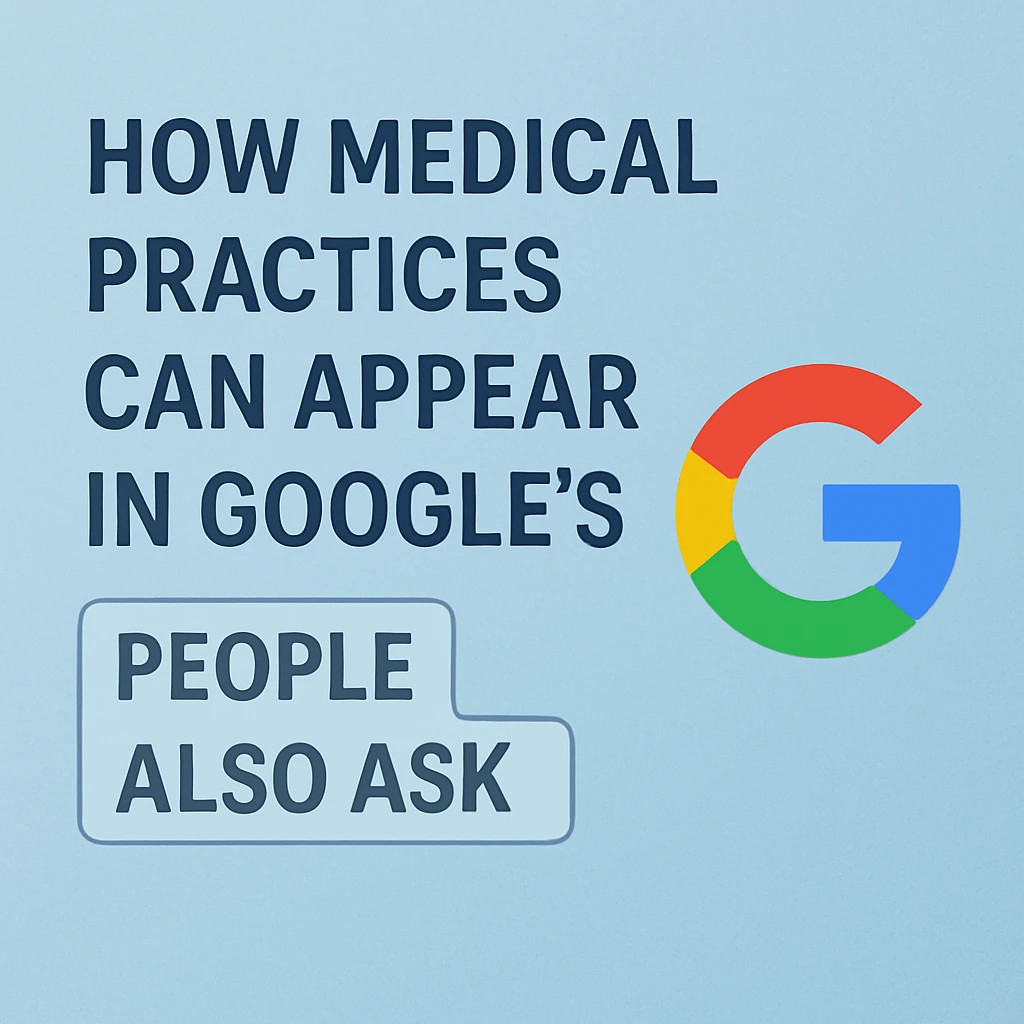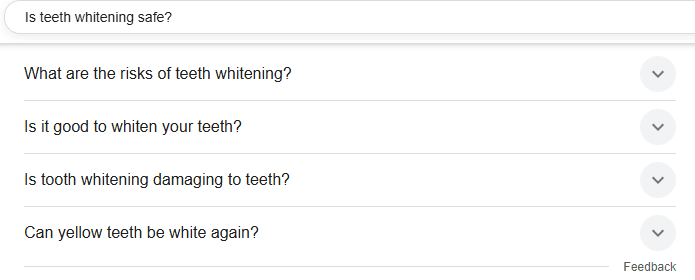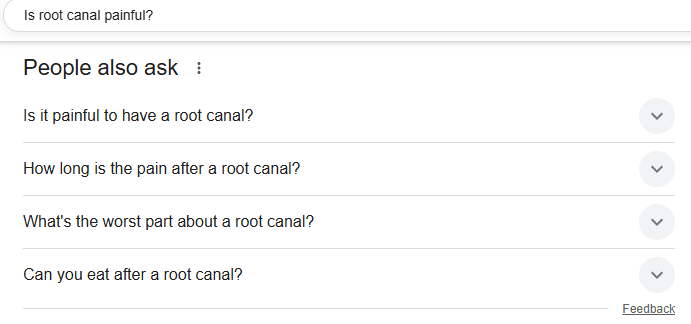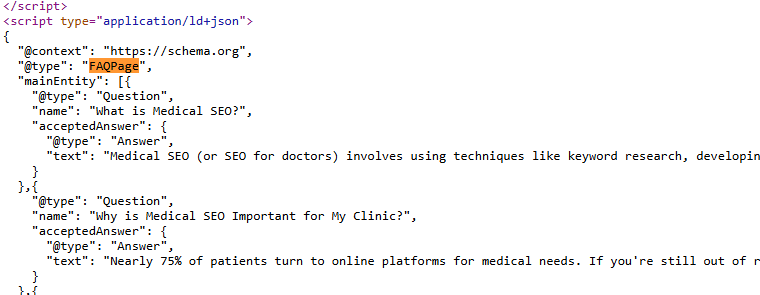
Limited time offer – Zero commission on Google Ads
You only pay what you spend on your Google Ads, no commission or hidden charges
“People Also Ask” (PAA) has become one of the most interesting features on Google’s search results page—especially for healthcare providers. For some, it’s a clear opportunity to boost visibility, answer patient questions directly, and build trust right from the search results. For others, it feels like another SEO puzzle: unpredictable, ever-changing, and hard to crack. And for the skeptics, it may seem like just another space dominated by large websites with endless content budgets.
But if you understand how the PAA box works and how to tailor your content for real patient queries, it can become a practical tool to drive qualified traffic and reinforce your expertise. In this article, we’ll break down exactly how medical practices can appear in Google’s “People Also Ask”—and why it’s worth paying attention to in 2025.

Google’s “People Also Ask” (PAA) section is an expandable box that appears in search results, displaying a list of common questions related to the user's recent search. When you click on one of those questions, it opens with a short answer taken from a website, along with a link to that page.
For medical practices, this is a great opportunity to show up in front of potential patients, even if your website isn’t ranked #1. If your website content answers these why, what, who, when, and where-related questions your potential patients are searching for (like “How often should I get a dental cleaning?” or “Is teeth whitening safe?”), Google may feature your answer in the PAA section.
Being visible here builds trust, enhances your online presence, and can attract highly relevant traffic. It’s like showing up in the right conversation at exactly the right time.
The purpose of the “People Also Ask” (PAA) section is to help users quickly and easily explore related questions. Every time a user searches for something on Google, its algorithm identifies other related questions that people have frequently asked in the past around that same topic.
Based on these patterns, Google scans its index and selects the most relevant questions connected to the original search. It then displays them in an expandable list, known as the “People Also Ask” box.
When someone clicks on one of these questions, it expands to show a brief answer pulled directly from a relevant web page—along with a clickable link to that source for more information. For example, if someone searches “Invisalign vs. braces, which are more effective?”, Google might display related questions like “Are Invisalign results better than braces?” or “Which works faster, braces or Invisalign?” Each answer is taken from a page that Google believes provides clear and helpful details.
This helps users to get quick answers without having to visit multiple websites. At the same time, it gives you a valuable opportunity to appear in front of potential patients—even if their site doesn’t rank first in traditional search results.
Google’s “People Also Ask” questions provide medical practices with a direct window into what potential patients are truly searching for. These automatically generated questions uncover genuine concerns, general uncertainty, and intent-driven queries that your audience is currently typing into Google.
These are the most significant advantages of PAA optimization for a medical practice:
1) Improve Visibility
When the content on your website addresses related terms around a patient’s original search, it increases the chances of your site appearing in Google’s “People Also Ask” section. This added exposure can push your website above traditional organic results and improve it's visibility.
Unlike standard rankings, PAA placements are triggered by relevance to user intent, not just position. That means even if your website isn't ranked #1, you can still show up near the top of the page by clearly answering the questions people are actively asking. You can also improve your visibility with local SEO for doctors to complement your content strategy.
2) Builds Topical Authority
When your website consistently appears in Google’s “People Also Ask” boxes, it sends strong signals to Google that your content is reliable and relevant to the topic. Over time, this helps establish your site as a trusted source of information within your niche.
This ongoing visibility supports your overall E-E-A-T, which are critical factors that Google uses to assess content quality, especially in healthcare. As your site gains topical authority, it becomes more likely to rank higher for other related searches.
3) Drives High-Intent Traffic
These PAA results make your potential patients curious to click and learn the related answers. This works even more effectively when the questions closely match what they’re already thinking. Since these queries are often specific and tied to real dental needs, the users clicking are usually already in the mindset to take action.
By providing clear, helpful answers in your content, you attract high-intent users who are actively searching for solutions. This improves your chances of driving them to your website and converting them into actual patients by securing positions in PAA boxes. Ultimately, it brings more highly convertible traffic to your site. For more strategies,checkout our SEO services for doctors to learn how to boost organic traffic.
4) Increases Brand Trust and Recognition
Your patients are more likely to trust your practice when they see it repeatedly featured in Google’s “People Also Ask” answers. Each appearance associates your name with clear, authoritative information, reinforcing your credibility before they even land on your site. Over time, this consistent visibility builds brand recognition and positions you as the go‑to expert—making them more inclined to choose your clinic when they’re ready to book an appointment. Use strategies like reputation management to further strengthen this trust.
5) Improves Click-Through Rates (CTR)
The more relevant your website content is to a patient’s exact question or intent, the more likely they are to click on it. When your answer in the PAA section speaks their language—using terms they understand and addressing concerns they actually have—it creates a natural connection.
A clear and personalized answer always increases the chances they’ll choose your link over others. That relevance drives stronger click-through rates and brings in users who are a perfect fit for your practice. Content marketing for dentists can help structure your messaging for maximum impact.
6) Supports Voice Search Optimization
Google is always working to deliver faster and more helpful answers. A significant portion of the content displayed in the PAA box is also utilized for voice search responses.
So, when someone asks a dental-related question using a voice assistant, Google may pull the answer from the same trusted sources it shows in PAA. If your website appears often in these results, it tells both users and search engines that your content is reliable. This kind of visibility builds trust, increases your reach, and helps your dental practice stay ahead as voice search continues to grow. You can explore our guide on voice search optimization for more insights.
7) Highlights Content Gaps and Keyword Opportunities
Google’s PAA questions highlight the specific topics and concerns that your current content may be missing. These are real patient queries that often aren’t fully addressed across existing websites. This gives you a sense and insight into clear opportunities to step in. You can uncover current gaps in your content strategy by analyzing these questions and queries and refine new keyword opportunities. For a stronger foundation, start with a free dental website that you can easily expand with SEO-ready content.
As it stands, there’s no direct way to submit your content or guarantee that Google will feature your practice in a "People also ask" (PAA) box. These selections are made by Google's algorithms, which are designed to understand the natural flow of a searcher's inquiry and provide the most relevant subsequent questions and answers.
However, this provides an excellent opportunity for medical practices. The PAA section is a roadmap to a potential patient's mindset. By understanding and optimizing for it, you can dramatically increase your practice's visibility, build trust, and establish your practice as an authority. One of the best ways to earn these placements is to think like a patient on their healthcare journey. So, when creating content for your website, it's crucial to anticipate their follow-up questions and structure your information in a way that Google can easily extract as a direct answer.
Here are the top things you can do to increase your chances of being featured in the "People also ask" section:

When a potential patient researches a medical condition or treatment, they rarely have just one question. They have a series of related inquiries. To get into the PAA box, you must think beyond a single keyword and address the entire "cluster" of questions.
For example, a patient searching for "Is root canal painful?" will almost certainly have follow-up questions like, "How long will root canal pain last?" and "What is the recovery time for root canal treatment?" Creating a single, comprehensive page that answers all these related questions in a logical sequence makes your content extremely valuable to both the user and Google. This significantly increases your chances of being featured for one or more of those queries.
The "People also ask" feature is essentially a list of frequently asked questions. The most effective way to optimize for it is to mirror this format in your content. Structure your blog posts and service pages with clear questions as headings, followed by direct answers.
From an SEO viewpoint, using headings (like H2 or H3 tags) for your questions (e.g., "What Are the Early Symptoms of Gum Disease?") helps search engine crawlers immediately understand the topic. Following that question with a concise, clear paragraph or a bulleted list provides a perfectly formatted answer for Google to pull into a PAA snippet. This structure improves readability for your patients as well as makes your content technically ideal for PAA features.
While your expertise is deep, the answers featured in PAA boxes should be typically short and easy to digest, usually between 40-60 words. The key is to provide a direct answer to the question immediately, written in simple, accessible language. Avoid using overly technical medical jargon that a patient may not understand.
For medical content, Google's E-E-A-T (Experience, Expertise, Authoritativeness, Trustworthiness) guidelines are paramount. Your concise answer should be backed up by more detailed, expert information further down the page. This combination of a simple, direct answer followed by comprehensive, authoritative content is the perfect formula for earning trust and PAA Boxes placements.
Do you know that one of the best content strategy tools is Google itself? To find out what questions your potential patients are asking, you can start by searching for your primary services (e.g., "orthodontist in [Your City]" or "cosmetic dermatology treatments").
Look at the PAA box that appears. These are the exact related questions Google's data shows that your potential patient is more likely to search for. Click on a few of them, and the box will expand with even more questions. This is a goldmine of content ideas handed to you directly by Google. Build your blog posts and FAQ pages around these proven topics to align your content strategy perfectly with user search behavior.

Structured data, or schema markup, is a type of code that you add to your website to explicitly tell search engines what your content is about. For PAA optimization, the FAQPage schema is incredibly powerful.
By wrapping your page's Q&A sections in FAQPage schema, you are flagging to Google that this content is specifically structured to answer frequently asked questions. This can help Google pull your answers into the PAA box and can also enable a rich snippet to appear directly under your result in the search rankings, displaying your questions and answers in an accordion format. This makes your search result larger, more interactive, and much more likely to be clicked.
Google is more likely to feature answers from a website it views as a comprehensive authority on a particular topic. A single blog post about orthodontics is sufficient, but a website with multiple, interlinked pages covering Invisalign, traditional braces, adult orthodontics, retainers, and treatment costs is even more effective.
Develop content "hubs" or "pillars" around your core medical or dental services. This involves creating a main, comprehensive "pillar" page about a service (e.g., cosmetic dentistry) and then creating multiple "cluster" pages or blog posts that go into detail on related topics (veneers, teeth whitening, bonding) that all link back to the main pillar page. This strategy signals to Google that your practice has deep expertise in that specialty, making you a more trustworthy source for PAA answers.
Sometimes your practice might already be ranking for a PAA result without you even noticing. So, make sure you regularly monitor which questions are appearing in Google’s PAA section for your most important keywords.
Use tools like Google Search Console, SEMrush, or Ahrefs to track what patients are asking about specific topics. These tools can reveal exactly where your practice is showing up—and where new opportunities exist.
Once you identify these questions, expand your content to answer them more clearly and personalized. That might mean updating your treatment pages with a short Q&A section, turning patient questions into blog posts, or rewriting answers to be more concise and readable.
Also, when someone clicks these PAA questions in search results, more related questions appear underneath. These follow-up queries offer insight into what else your patients are curious about—and what content you could create next. By continuing to monitor and build around these questions, you increase your chances of showing up again and again.
The "People also ask" section has become a fundamental part of the patient's online research journey. In that case, earning and maintaining placement in these boxes can really be a powerful way to increase your practice's visibility, drive highly qualified organic traffic, and build trust. By focusing on your potential patient's search intent, answering their questions comprehensively, structuring your content logically, and signaling your expertise to Google, you can significantly improve your chances of positioning your content to appear in PAA boxes.
Need help scaling your strategy? Our comprehensive medical marketing services can guide you.
Get in touch with our healthcare marketing expert